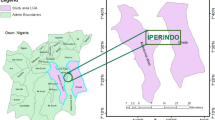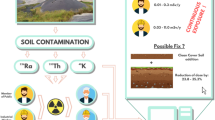Abstract—
The mining industry adversely impacts natural environments and contaminates them with accessory elements, including so-called primordial radionuclides: the 238U, 232Th, and 40K isotopes. The towns of Kapan and Kajaran are the largest mining centers of Armenia, at which Cu, Mo, and other metals were mined and processed starting in the 1950s. Our study was centered on the technologically enhanced natural radioactivity of urban soil and wastes of the mining industry and on the evaluation of the radiation doze and excess lifetime cancer risk induced by naturally occurring radioactive materials. These studies have shown that industrial facilities in the town of Kapan are the main factors of the redistribution of radionuclides in the urban soil, but the health risks mostly do not exceed the global average levels because of the low level of the natural radioactivity of the ore. The natural radioactivity of soil in Kajaran is controlled by the parent rocks of the soil (these are intrusive rocks, mostly monzonite), and the mining facilities only insignificantly affect the radioactivity redistribution. The higher natural radioactivity of the urban soils at Kajaran causes a potential health risk.








Similar content being viewed by others
REFERENCES
K. Al Nabhani, F. Khan, and M. Yang, “Technologically enhanced naturally occurring radioactive materials in oil and gas production: a silent killer,” Process Saf. Environ. Protect. (99), 237–247 (2016)
P. G. Aloyan, Uranium Potential of Geological Formations of Armenia (GEOID, Yerevan, 2010) [in Russian].
S. I. Arbuzov and L. P. Rikhvanov, Geochemistry of Radioactive Elements. A Textbook (Tomsk. Politekhn. Univ., Tomsk, 2010) [in Russia]. A. T. Aslanyan, Regional Geology of Armenia (Aipetrat, Yerevan, 1958) [in Russian]. A. B. Bagdasaryan, Physical Geography of Armenian SSR (ArmSSR, Yerevan, 1971) [in Russian].
F. P. Carvalho, “Mining industry and sustainable development: time for change,” Food Energy Secur. 6 (2), 61–77 (2017).
W. G. Cochran, Sampling Techniques (John Wiley & Sons, 1977).
Geology of Armenian SSR. Vol. 6. Metallic Mineral Resources (AN ArmSSR, Yerevan, 1967) [in Russian]. IAEA-TECDOC-1271 Technologically Enhanced Natural Radiation (TENR II). Proceedings of International Symposium. Rio de Janeiro, 1999 (IAEA, Vienna, 2002).
ICRP Recommendations of the International Commission on Radiological Protection. Publication 60 (Pergamon Press, Oxford, New York, Frankfurt, Seoul, Sydney Tokyo, 1991) 442 p.
ISO 18512:2007. Soil Quality – Guidance on Long and Short Term Storage of Soil Samples
ISO 18589-6:2009. Measurement of Radioactivity in the Environment—Soil—Part 6: Measurement of Gross Alpha and Gross Beta Activities.
R. K. Jain, and Z. Cui “Cindy,” and J. K. Domen, “Environmental impacts of mining,” Environmental Impact of Mining and Mineral Processing. Management, Monitoring, and Auditing Strategies (Butterworth-Heinemann, Boston, 2016), pp. 53–157.
A. E. Kocharyan, Extended Abstract of Doctoral Dissertation in Geology and Mineralogy (Inst. Geol. Nauk AN ArmSSR, Yerevan, 1969) [in Russian].
V. I. Komashchenko, V. I. Golik, and K. K. Drebenshtedt, Environmental Impact of Prospecting and Mining Industry (KDU, Moscow, 2010) [in Russian].
E. R. Landa “Naturally occurring radionuclides from industrial sources: characteristics and fate in the environment,” Radioactivity in the Environment, Ed. by E. Shaw G, 10, 211–237 (2007).
S. S. Mkrtchyan, Zangezur Ore-Bearing District of the Armenian SSR (AN ArmSSR, Yerevan, 1958) [in Russian].
National Atlast of Armenia. Volume A. (Tigram Mets, Yerevan, 2007), pp. 74—75.
M. I. Ojovan and W. E. Lee, “Naturally occurring radionuclides,” An Introduction to Nuclear Waste Immobilisation, 2nd Ed. (Elsevier, 2014), pp. 31–39.
A. S. Paschoa and F. Steinhäusler, “Terrestrial, atmospheric, and aquatic natural radioactivity, in Radioactivity in the Environment, Ed. By A. S. Paschoa and F. Steinhäusler (Elsevier, 2010), Vol. 17, pp. 29–85.
A. I. Perelman and N. S. Kasimov, Landscape Geochemistry (MSU, Moscow, 1999) [in Russian].
B. A. Revich, Yu. E. Saet, and R. S. Smirnova, Methodical Recommendation on the Geochemical Assessment of Urban Pollution by Chemical Elements (IMGRE, Moscow, 1982) [in Russian].
L. Rikhvanov, P. Radioactive Elements in the Environment and Problems of Radioecology: A Textbook (TPU, Tomsk, 2009) [in Russian].
Yu. E. Saet, B. A. Revich, and E. P. Yanin, Environmental Geochemistry, (Nedra, Moscow, 1990) [in Russian].
A. K. Sagatelyan, V. Sh. Gevorkyan, S. G. Arevshatyan, and L. V. Saakyan, Ecologcial-Geochemical Assessment of the Kadzharan Environment (Ts. Ekol-Noosf. Issled. NAN RA, Yerevan, 2008) [in Russian].
A. Saghatelyan, L. Sahakyan, O. Belyaeva, and M. Mikayelyan, “Heavy metals accumulation in system soil-farm crops under the impact of mining industry,” In Articles of the First Symposium on Medical Geology (Geological Survey of Iran, Tehran, 2010), pp. 38–46.
A. K. Sagatelyan, L. V. Saakyan, M. G. Mikaelyan, and O. A. Belyaeva, “Ecological-geochemical analysis of risks of the influence of mining-ore industry on the stable development in Armenia,” Izv. Ross. Akad. Nauk, Ser. Geograf., No. 5, 87–93 (2010).
A. Saghatelyan, L. Sahakyan, and O. Belyaeva, “Polluted irrigation waters as a risk factor to public health,” Chemistry Journal of Moldova. General, Industrial and Ecological Chemistry 7 (2), 84–88 (2012).
L. Sahakyan, O. Belyaeva, and A. Saghatelyan, “Mercury pollution issues in Armenia’s mining regions,” In Processings The 15 th International Multidisciplinary Scientific Conference SGEM 2015. Vol. 1. Ecology & Environmental Protection (Alben, 2015), pp. 513–520.
Statistical Yearbook of Armenia. A Total Review (Statistical Committee, 2019). https://armstat.am/file/doc/99516733.pdf
Statistical Yearbook of Armenia. Industry (Statistical Committee of Republic of Armenia, 2019a). https://armstat. am/file/doc/99516788.pdf
G. Tepanosyan, L. Sahakyan, O. Belyaeva, Sh. Asmaryan, and A. Saghatelyan, “Continuous impact of mining activities on soil heavy metals levels and human health,” Sci. Tot. Environ. 639, 900–909 (2018).
N. A. Titaeva, Nuclear Geochemistry (MSU, Moscow, 2000) [in Russian].
UNSCEAR. Sources and Effects of Ionizing Radiation. Vol. I. № Annex B (2000).
US EPA EPA QA/G-5S: Guidance on Choosing a Sampling Design for Environmental Data Collection (Office of Environmental Information US EPA Washington DC, 2002).
V. Valković, “Radioactive nuclides in nature,” In: Radioactivity in the Environment, 2nd, Ed. (Elsevier, 2019), pp. 1–29.
S. S. Vanyushin, Yu. A. Leie, and E. G. Malkhasyan, Kafan Copper Deposit: Geological Structure and Prospects (Kavkazsk. Nauchn.-Tekhn.. O-vo Tsvet. Metallurg., Yereva, 1957) [in Russian].
F. K. Vosniakos, “Status of the problem,” in Radioactivity Transfer in Environment and Food. Environmental Science and Engineering. (Springer, Berlin—Heidelberg, 2012), pp. 1–22.
ACKNOWLEDGMENTS
The authors thank the staff of the Department of Environmental Geochemistry at the Center for Ecological–Noosphere Studies, National Academy of Sciences of the Republic Armenia, and the staff of the Laboratory For Environmental Protection of the Armenian Nuclear Power Plant for providing factual materials for this research.
Funding
The ecological–geochemical studies in the town of Kajaran were financially supported by the OSCE office in Yerevan and the municipality of the town of Kajaran in 2005. The paedogeochemical survey in the territory of the town of Kapan was financially supported by the OSCE office in Yerevan in 2007. The radiological study was conducted under government-financed research project for the Center for Ecological–Noosphere Studies, National Academy of Sciences of the Republic Armenia, in 2016.
Author information
Authors and Affiliations
Corresponding author
Additional information
Translated by E. Kurdyukov
Rights and permissions
About this article
Cite this article
Demirchyan, G.A., Movsisyan, N.E., Pyuskyulyan, K.I. et al. Radiological Studies at the Largest Mining Centers of Armenia. Geochem. Int. 60, 122–136 (2022). https://doi.org/10.1134/S0016702922010049
Received:
Revised:
Accepted:
Published:
Issue Date:
DOI: https://doi.org/10.1134/S0016702922010049




